Following on from last week, I think an interesting part of any country's cuisine is the trying of foods that make you squirm a little, the delicacies that you can amaze your friends and family by saying you've tried when you get back home, so this is where we will start part 2.
And Now for Something Completely Different
Live Octopus (산낙지) - most commonly this is only the tentacles cut up and served with some seasame oil and salt on the side. Still wriggling, the tentacles must be chewed quite a lot to avoid the suckers sticking to your throat on the way down. The taste is really not that bad at all. If you want some really hardcore delicacy action, however, you can eat the whole octopus live by wrapping it around some chopsticks and putting it all in. I have never tried this, and I am slightly fearful to do it as I have heard that people die eating it like this, especially when already a little tipsy on soju. The octopus obviously sticks inside peoples throats and chokes them to death. I don't fancy picking up a Darwin Award for such silly night-time antics.
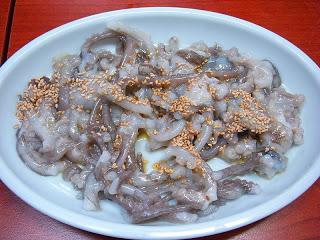
San Nakji by LWY at flickr
Fermented Ray (홍어) - I have never tasted anything worse. I am a great admirer of Bear Grylls and if you have watched any of his shows you will know that he will eat just about anything and I am similar. I don't tend to gag or have any prejudices about eating anything (I do draw the line at dog, however). I have eaten 홍어 twice, it is usually served with a bit of fatty grisley pork and kimchi, but it doesn't manage to take the taste away, which is truly horrible and the closest I have ever come to being sick right-away after eating something. The pungent smell of the fermented fish also gets right up your nose. Worth a try once, but be warned!
Silk Worm Pupa (번데기) - These are often sold as snacks in little paper cups on street stalls and I rather like them. One cup is quite filling as it must be quite high in protein. Apparently (so Bear Grylls says), insects - pound for pound - contain more protein than beef. As a keen hiker, it is difficult to carry high protein and cheap foods with you on a hike, so I have gotten into the habit of carrying a tin or two hiking with me and either eating them straight out of the tin or putting them in a sandwich with some tomato ketchup. I also cook 번데기 fried rice for dinner sometimes, although my wife says it gives me bad breath, so I am banned from eating this when she is around and she accuses me of eating 'pig food'. Seeing as she has gone to Australia, however, I can eat with freedom for a while, and in fact, the first two nights she was away, I ate it both nights. It ain't great, but it is nutritious and cheap.
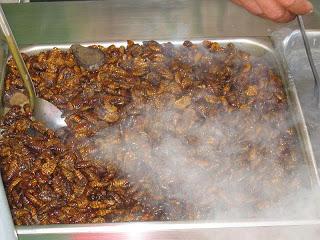
Raw Seafood (회) - If you go to a raw seafood restaurant in Korea, you can sample some really great, tasty and healthy food, but there are some slightly dodgy things on the menu also and if you are with some mischievous Koreans they might well order it for you, as happened to me one week into my Korean experience many years ago. A couple of the more, shall we say, acquired tastes are Sea Squirt and Gae Bul (a pink sea spoon worm that looks like a penis and obviously good for a man's stamina in bed). The Gae Bul was as bad as the 홍어 and the sea squirt was just bizarre and difficult to eat.
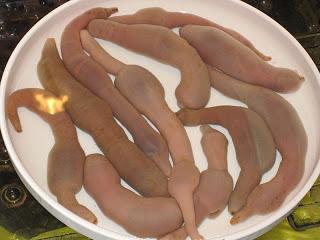
| Gae Bul: Photo by J. Patrick Fischer |
Great Soups
Eel Soup (장어탕) - I have this at school quite a lot and I have to say that I get quite excited when I see it in the pot. Usually, the whole eel is ground up into a paste in the soup so you eat bones, sinew and all amoungst the other ingredients and it is very spicy. As with many dishes in Korea, it is a whole lot better than it sounds. I did once have it with sliced sections of eel in it, however, on Geoje island, which wasn't so good because I had to spit out a lot of bones, but the soup still tasted great.
Spicy Fish Soup (매운탕) - Bit of a tricky one to eat as there are often a lot of bones, fins and other fish parts in it, but it is spicy, wholesome and delicious. I remember once having it after I finished running a marathon, and although I was sceptical that a spicy, fishy soup was the best thing I could be eating straight after running all that way, once I had some I felt almost immediately rejuvenated.
Heavily Fermented Bean Soup (춘국장) - the stronger, fuller-flavoured elder brother of 된장찌깨
(doenjang soup) is an aquired taste as it has a strange flavor and intense odour. As always very good for you.
Bone Soup (설렁탕) - There are a few varieties of bone soup, but I am picking the one I know best and like best, 설렁탕 (Solongtang). This is a bone soup with sliced beef, served with rice, salt, and radish kimchi, which is usually mixed all together. If I can recommend one soup to really make you feel strong and healthy it would be this one. It often makes me feel like a new man after eating it and this feeling is something I really like a lot of Korean dishes for. They don't just fill your stomach and taste good, but they make you feel great as well.
Motorway Service Station Food
When you first come to Korea, it might just be that you need to go on a fairly long bus journey to get to your destination. On the way you will stop at a service station, and besides the sit-down food you can eat there serving the usual fare, you will find other food that is quite specific to motorway service stations. Not the healthiest usually, but will temporarily fill a hole in your stomach.
Fish Cake on a Stick - And other stuff on a stick with mustard and ketchup. It is Korea's answer for hot dogs, which they also serve at service stations. My personal favorite is a Doek Dog, which is crispy Korean rice cake on the outside and a frankfurter in the middle.
Walnut Cake (호두 과자) - my favorite long-journey snack food. Best when it is warm, but be careful not to burn your tongue on the red bean paste inside. Crispy on the outside with a walnut also, they are lovely and sweet without being grossly unhealthy.
Roast Potatoes - I was slightly surprised by this as I thought Korea wasn't a particularly potato liking country. They sell mini roast potatoes at many stops and most Korean people I have ever seen eating them put so much salt on them, it is almost unbelievable.
Pumpkin Candy (엿) - Come in small plastic boxes and cost about a couple of dollars. It doesn't look that great value as it seems there is not much there. However, they are quite chewy and surprisingly long-lasting. Quite subtlely sweet and satisfying to chew on, with quite a unique texture and flavour, they can end-up being quite addictive.
There are many other foods that you can buy at these stops, which seems to be the same at every one, including:
Corn on the cob
Takoyaki (Japanese snack, and another favorite little snack of mine)
Deli Manjoo (sort of vanilla cream in a soft batter)
Whole fried squid
Sweet potato fries
Sandwiches (Korean style)
Tteokbokki
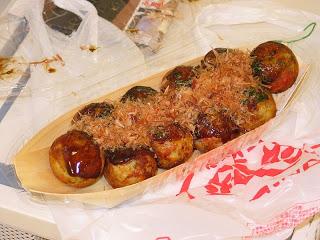
Takoyaki: Photo by Keith Pomakis on 2004-09-18.
There are almost certainly too many to name, as kimchi alone has about 200 different varieties. An American friend of mine once said Korea was, "the land of side dishes no one wants to eat", and I used to agree with him, but as my Korean food appetite has matured and grown, the side dishes have also come into their own. Many side dishes are vegetables, fish or egg served in a tasty sauce to make them more palatable. When my wife visited England with me she remarked about how blandly we cooked vegetables, often boiled without a sauce, Koreans rarely do this and there can also be an incredible range of different side dishes with different meals.
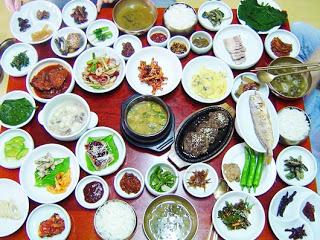
I think it is fair to say I could go on and on about Korean food. When I wonder around the city, I can see so many foods that I haven't yet tried, so I still have a way to go yet on sampling everything Korea has to offer in the food department and this makes me even more puzzled when people say it lacks variety. There is no way I could even come close to doing the same two-part post on delicious English food.
Perhaps there is a reason, though, why Western people say Korean food lacks variety; maybe we Westerners indulge ourselves in other culture's food much more often than Koreans do. Sure, Koreans like their Western food, Japanese food, and sometimes Chinese food, but they are often Koreanised slightly and they eat them far less often than Korean food. Most Koreans I know really love their own food, I can't say the same for English people. Yes, we love a good roast dinner, but we also love an Indian or Thai curry, a take-away Chinese, Mexican food, Italian food, etc. We eat other culture's foods far more often, in my experience, than Koreans do and I think this goes for most people from Western countries. This rings so true in England that apparently the Chicken Tikka Masala is the nation's favorite food and is now even considered an English dish.
So when you consider that most of the time in Korea, Koreans that you are with are eating almost solely Korean food and they enjoy the pleasure of introducing you to it, perhaps then you might be able to see that it is not devoid of variety at all.
Personally, I eat a Pizza about once every 3 weeks and the rest of the time I eat Korean food. I never get bored, I feel great, energetic, and I am almost certainly much healthier for it. My favorite food in the world, I always miss Korean food badly when I leave Korea.
